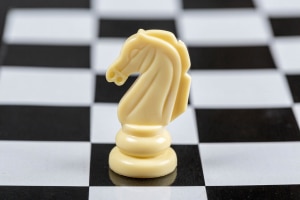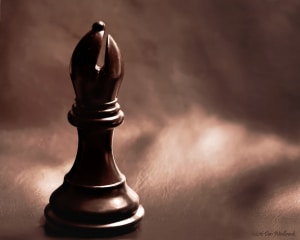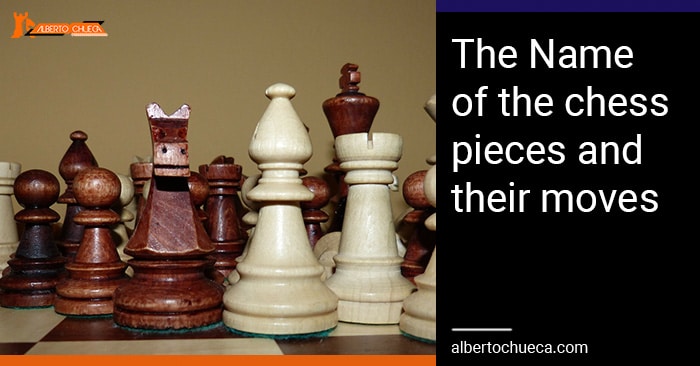Table of Contents
The name of the chess pieces and their moves
We've learned in previous articles about the chess pieces and their moves. This article will be sort of a “recap” as to the name of the chess pieces and their moves, so if you don't have time to read several articles, you can read this, but the other articles will have more details for those of you who enjoy such things! :)
The name of the chess pieces and their moves: pawn
The pawn, as you can see in the image below, simply looks like a figure with a round head, not too much glamour to its look.

There are a bunch of chess pawns lined up in the photo above. The chess pawn can move one square on a regular basis, two turns on its first move, though it also has the option to move one square on it's first turn as well.
The position above is a common opening called the French Defense. White moved their e-pawn up two squares, Black chose to move their e-pawn one square, giving White a space advantage.
The pawn is involved with two special rules: promotion and en passant. Pawn promoting is when the pawn reaches the end of the board, it has the option to turn into a Queen, Rook, Knight, or Bishop. En passant is when an enemy pawn moves 2 squares and lands next to your pawn, it can capture upwards diagonally on its first chance.
The chess Knight
The Knight if you remember is a unique piece. They look like a horse ready for war!

We can see by the structure that it indeed does look like a horse, although, we should not call the Knight a horse, as many people conceive it to be!
The Knight has a very unique skillset. Unlike other pieces, which generally move in some line, the Knight moves in a specific L-shape path. If you are on a real chessboard, the way you can remember is to move the Knight onto one square, then turn two squares, or you can do two squares then turn one.
The Knight on e4 in the diagram above can move to any of the squares an arrow is pointing to, using the method to hop one square, then turn two, or vice versa.
The Knight is also unique because the Knight is the only piece who can jump over other pieces, either their own or the enemy.
The Knight's path from e3-f5 has been highlighted. Note how there is a black pawn in the way. Normally, you can't move a piece to a square if that path is obstructed by another piece, although, Knights are an exception. Please note that you do not capture the piece you jump over, you only capture a piece on the square you land on. When learning the name of the chess pieces and their moves, the Knights tend to be very tricky!
The chess Rook
The Rook is structured like a castle or at least a section of a castle.

After this, We're halfway through learning the name of the chess pieces and their moves! The chess piece surrounded by the two pawns is the Rook. Their movement is very straightforward (no pun intended!). The Rook moves in a straight line in any direction, vertically or horizontally.
You can see the Rook's movement above. It can be helpful to think of its movement like a “plus” (+) sign, as you can see above!
The Rook is involved in a special type of chess movement, called castling. This is when there are no pieces between the King and the Rook to obstruct the castle, the King can move two squares towards the Rook, and the Rook flips over.
In the position above, the King can move from e1-g1, and the Rook can swing from h1-f1.
The chess Bishop
The Bishop in chess is based on a religious figure Christianity, and they are iconic because of the hat structure on them that real-life Bishops wear.

The Bishop moves similar to a Rook, but it's different. They move in a diagonal direction on any side of the chessboard.
Kind of how the Rook moves like a plus sign, the Bishop moves like an “X”, or, if you are a math nerd, it moves like a multiplication symbol! :)
Name of the chess pieces and their moves: The King and Queen

The King and Queen, though similar figures in real life, are two very different chess pieces! The Queen is the most powerful piece on the board, the King is the most important piece on the board. What do I mean by that?
The Queen has the powers of a Rook and Bishop combined. Can move like that “+” and “X” symbol!
We see above, the Queen functioning like a Rook (red arrows) and a Bishop (green arrows). No wonder the Queen is so powerful!
The King is a different story, it can only move one space in any direction.
The goal of the game is to checkmate the King, in other words, attack it to where it cannot move anywhere safely. This makes sense as the King has extremely limited mobility.
We have now learned the name of the chess pieces and their moves! Go start a game.






